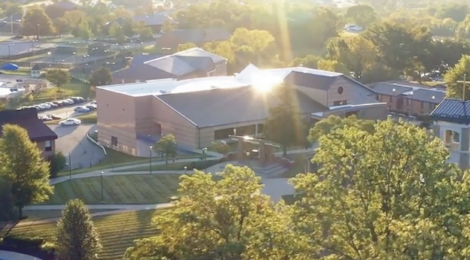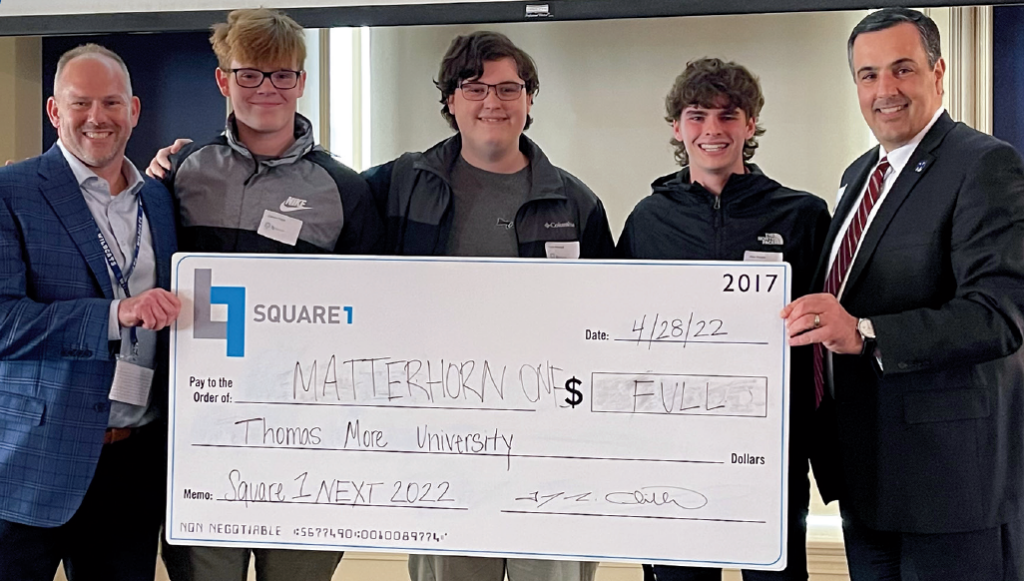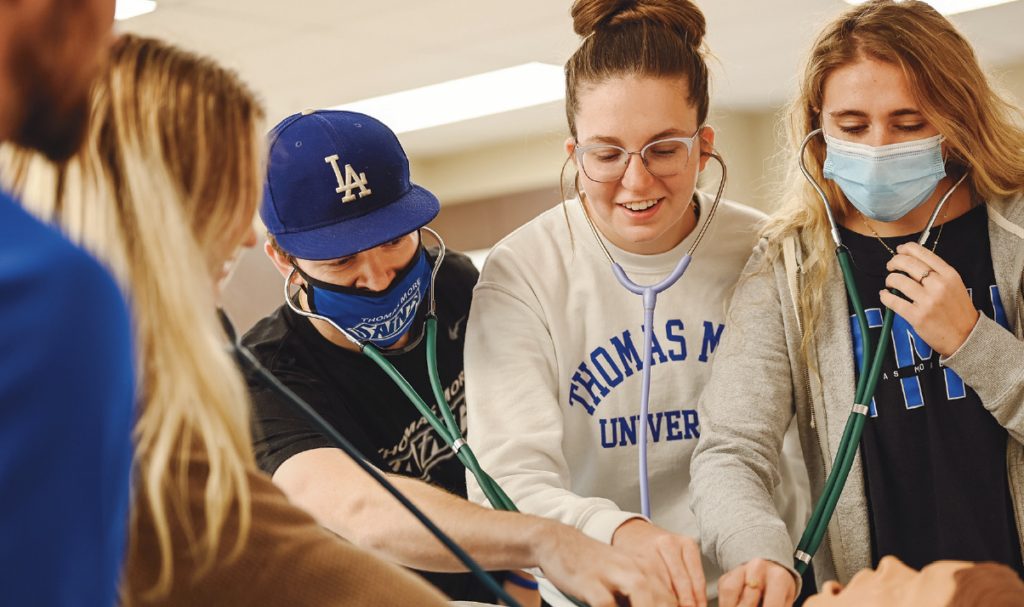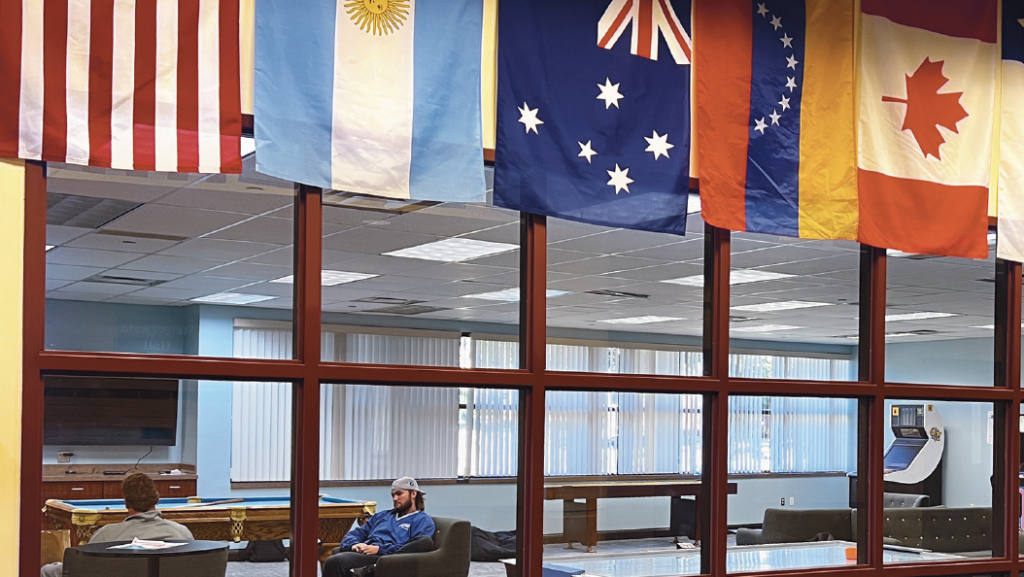
Lighting the Way into the Second Century
SUBMITTED BY LYNA KELLEY, DIRECTOR OF COMMUNICATIONS AND PR
AND JUDY CRIST, EXECUTIVE DIRECTOR COMMUNICATION AND CREATIVE SERVICES
The Second Century Campaign – It’s time for More continues to surpass goals. Through the support of this capital campaign, academic, administrative, and physical changes are taking place on the University campus fueled by the initiatives set forth in the 2021-2026 Strategic Plan – Lighting the Way. The success of the Second Century Campaign ensures the University reaches aspirational goals developed through the strategic plan; to impact the community with the intention to be the premier Catholic university in the region. Primary to all work done, is ensuring that students at Thomas More are both successful in career and in life.
Student success revolves around providing the support necessary academically, socially (i.e. through athletics, extra-curriculars, networking), personally, and financially. Financially, Thomas More ensures all traditional students receive some sort of assistance whether it is through scholarships, work ship, work study, or grant access. Finding new ways to increase opportunities for deserving students to receive scholarship dollars is always top of mind and there are several avenues at Thomas More for those who shine through academics, in service to the community, through leadership, in athletics, and now through innovation. The spring Moreover introduced the Dr. Anthony ’65 and Geraldine ’66 Zembrodt Center for Entrepreneurship & Innovation. In partnership with Square1, the Center is pleased to announce that the first student recipients of Innovation Scholarships are now on campus. Carson Floyd and Colin Wilmhoff, members of the Beechwood High School Materhorn1 team which won Square1’s Final Pitch contest in spring 2022, are now Saints. Final Pitch is similar to a Shark Tank atmosphere with teams pitching entrepreneurial ideas to judges in a head-to-head competition.

In addition to institutional scholarships, and thanks to the support of alumni, families, and local entities, the University has over 100 endowed scholarships which make a Thomas More education possible for many students. Through the growth in endowed scholarships, both in number and in value, the University was able to award 9% more in financial support year-over-year from academic year 2020-21 to 2021-22.
In a new development St. Elizabeth Healthcare introduced financial support by establishing an endowed fund that will benefit junior and senior nursing students who are willing to commit to work for the hospital after their graduation date. The scholarships are the newest blessing that has developed from this relationship between these diocesan partners. St. Elizabeth has been a valuable relationship throughout Thomas More’s 100 year history, most recently as a resource in support of the athletic training/exercise science programs as well as providing financial support as a partner in procuring the Center for Health Sciences building on Barnwood Drive – current home of the health science programs. In recognition of the long-standing relationship, the University officially unveiled its first named college, the St. Elizabeth College of Natural and Health Sciences, on Sept. 30. “In naming the St. Elizabeth College of Natural and Health Sciences, we are solidifying the partnership of two mission-driven institutions that are committed to serving the regional community,” says President Chillo. “This partnership continues to be beneficial for our students. While obtaining a high-quality, Catholic liberal arts education at Thomas More, our students have opportunities to make valuable connections with St. Elizabeth Healthcare, that could lead to promising career placement.”

As the Center for Health Sciences building provided much needed space for the nursing and exercise science programs, so generous gifts have also improved the quality of the equipment used to educate these dedicated students. In July of 2022, the University officially named a nursing skills lab at this location the “Kathleen McLane Nursing Skills Lab” after the late Kathleen McLane, a devoted nurse who served the Northern Kentucky/ greater Cincinnati community until her sudden, accidental death in 1982. The dedication of the lab was made possible through a gift from alumni Mary (McLane) ’73 and S. Frank ’73 Fritsch. This gift allows the department to update and expand the lab to better train nursing students. “Kathy was a dedicated, loving, and kind nurse who was always there for her patients, her colleagues, her friends, and her family,” recalls her sister, Mary. “She was a true caregiver in every way! She’s remembered for her humble spirit.” A ceremony was held at the skills lab on what would have been McLane’s 70th birthday, on July 30, 2022. Through the Kathleen McLane Nursing Skills Lab, McLane’s legacy lives on, making an impact on the region’s future nurses.
In addition to upgrades in equipment at the Center for Health Sciences, the Science Building on the main campus has also reaped the benefits of an excellent donation. Thanks to a gift to the Second Century Campaign by the Dr. George A. and Delores E. Renaker Foundation, the biology department purchased an Anatomage Table. The Anatomage Table is the world’s only virtual dissection table and the most technologically advanced 3D anatomy visualization system for anatomy and physiology education. The new table is already being integrated into labs for Fall 2022 courses. And not to be soon forgotten, recently retired biology professor Siobhan Barone was honored with the naming of the K. Siobhan Barone Cell Culture Laboratory. This naming was made possible thanks to generous contributions from her admirers and colleagues to the University, and is a testament to her work and dedication as part of the Thomas More faculty for 28 years.
There are many other areas on campus that have been in flux from summer into fall. One of those is the Science Lecture Hall which has seen over 50 years of students revolve through its doors. A complete overhaul occurred with upgrades to seating and updates to the technology available in this much used classroom. In the same general area, down the hall across from the Benedictine Library you will now find the President’s Office as, true to his word, the Saints Center has been transformed back to a true student center with additional space available for study, meeting, collaborating, or just hanging out with friends and classmates.
At the June 2, 2022, meeting, the University’s Board of Trustees selected Turner Construction Company as the general contractor of the new Academic Center. “The selection of Turner Construction Company as the contractor for Thomas More’s new academic center moves our vision for expanded signature programs and new initiatives closer to becoming a reality,” says Judith Marlowe, Ph.D., chair of the Board of Trustees. “Upon careful review of the proposals submitted, Turner emerged as the company of choice given their experience with similar projects as well as the detailed preparation and analysis describing their proposed construction process. The academic center will increase our opportunities to foster engagement and collaboration that benefit not only our students, but also the community.” The University held a ceremonial ground breaking in spring 2022 and construction is now underway. When complete, the 35,000-square foot building will house advanced technology and state-of-the-art classroom environments, a 400-seat auditorium, a technology and prototype lab, the Dr. Anthony ’65 & Geraldine ’66 Zembrodt Center for Leadership, Entrepreneurship & Innovation, the Center for Faith, Mission, and Catholic Education, and the College of Business.
As the College of Business prepares for a new home, it has also been busy with ensuring there are experiential learning opportunities for business students through co-ops and internships. The Republic Bank Foundation Institute for Career and Graduate School Planning (ICG) is still an excellent resource for Thomas More students to pursue all manner of experiential learning opportunities, but the College of Business chose to place their focus on building relationships in the business community through the appointment of Debby Shipp as director of co-op and corporate engagement. Her goal is to increase the corporate network and ensure the name of Thomas More is top of mind and synonymous with high-quality students for talent pipelines to regional businesses. Also, in an effort to add value to the relationship the University has with the region, Debby is building a catalog of professional development courses. These courses are offered to local entities as a way to provide continuing education to their employee base by tapping into the expertise of faculty and staff. In this way, the scholarship displayed by faculty and staff, as defined through academic study and achievement, is shared with a wider base in the community surrounding the University.
With the concept of scholarship as it relates to academic achievement in mind, what is the University doing to improve the overall perception of Thomas More as an excellent place to fulfill higher learning goals? The University has always enjoyed a stellar reputation for academics and plans to continue that tradition into the next century. One method is to improve the position the University holds in the U.S. News and World Best Colleges Report. From 2021 to 2022 the University improved its position by nine spots in the best Regional South Universities category and moved up three spots in the Best Value category. More work is being done to share the great stories and work that Thomas More alumni, faculty, and staff take part in outside of the classroom in an effort to further improve this ranking.

The launch of the Center for Teaching, Learning, and Scholarship provides monthly workshops on a selection of topics intended to enhance faculty and staff learning and experience. Life-long learning enriches faculty/staff satisfaction both as individuals and as members of the college community. The University also received a NetVUE (Network for Vocation in Undergraduate Education) grant which is being used to create a professional learning community on campus that will explore how vocation, community, and student success is defined and used across campus. More information about this exciting initiative is available by CLICKING HERE. In addition to senior leadership working on the impact of vocation at Thomas More, leadership has also committed to a Kentucky-wide initiative being championed by the John N. Gardner Institute for Excellence in Undergraduate Education as it pertains to equitable student success. The Kentucky Council on Post-Secondary Education accepted an invitation to participate on behalf of the Commonwealth in a pilot program which explores strategies at the leadership level that impact diversity, equity, and belonging on a college campus. The initiative includes both public and private degree-granting institutions. Learn more in-depth information about this commitment, CLICK HERE.
While this initiative is at the statewide level, closer to home Thomas More is participating in the Dr. James E. Randolph Initiative. As explained when it was introduced in the spring Moreover, this initiative strives to increase diversity in STEM fields, specifically medical, healthcare, and in scientific research settings. Thanks to the hard work of faculty members William Wetzel, Ph.D., and Jyoti Saraswat, Ph.D., Thomas More hosts Holmes High School students on campus in November for a day-long introduction to the different avenues by which acquiring a college education can secure a career in nursing, exercise science, biology, or/and chemistry. High paying jobs at STEM organizations can improve upward mobility for this segment of the population, as well as increase much needed diversity in the field. Five different Black students and alums (Antonio Booker ’13, Jared Bulluck, Olivia Jackson, Dillon Powell ’20, and Louis Walker III ’16) from Thomas More were kind enough to participate in interviews which share their journeys to a career in STEM in support of the Randolph Initiative. This type of participation keeps the name of Thomas More in front of the community as a resource for making the region a better place where everyone can live and thrive.
In another turn of events which adds to the prestige of the Saints athletic program, it was announced in July 2022 that the National Collegiate Athletic Association Division II (NCAA DII) granted Thomas More provisional membership, making them the only Division II University in the Northern Kentucky/greater Cincinnati region. Participation in the NAIA for the past three years was excellent preparation as a pathway to DII, with the Saints playing out the 2022-23 year in the Mid-South Conference before moving to DII as member of the Great Midwest Athletic Conference. “The transition to the NCAA is significant as we continue to enhance our regional position as the premier Catholic Liberal Arts University,” says President Chillo. “The experience that we create for our student-athletes is intentional and designed for success in the classroom and on the field of competition. As we invest in our athletics program by adding new sports, full-time coaches, and renovations and expansions in facilities, this opportunity to elevate the position of Thomas More Athletics with the reputation and brand of the NCAA is a significant and transformational endeavor.” More information about this transition to NCAA DII is available, CLICK HERE.

One new sport added to the athletic program at the start of the 2022-23 academic year is esports. The program is part of the National Association of Collegiate Esports (NACE). Esports encompasses competitive, organized video gaming, which has emerged in recent years as one of the world’s most booming business ecosystems. To read more about esports as part of the Saints intercollegiate teams, CLICK HERE.
There is so much to be thankful for at Thomas More. Without the support of alumni and friends of the University, and the engagement of faculty, staff, and students, this region would not be what it is today. Northern Kentucky, southeast Indiana, and Greater Cincinnati as a whole benefit from the ties created by those who have been touched by this University. However you want to describe this symbiotic relationship, it has been a blessing for all.

Comments are closed, but trackbacks and pingbacks are open.